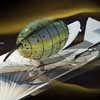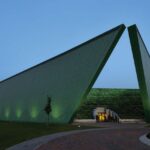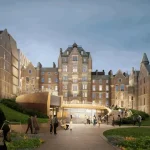Aurora Borealis Observatory, Arctic Architecture Design, Troms Building Proposal Image
Aurora Observatory : Arctic Architecture
Building Project in Troms, Norway – design by Margot Krasojevic
Animating Light Landscapes
Design: Margot Krasojevic
Building in Troms
8 Sep 2009
The Observatory Building in Troms
The Observatory, located in Troms a Northern Hemisphere in Norway, is where the Aurora Borealis’ occurrence is greatest during the winter months. Many travel to Troms to observe this atmospheric phenomenon.
The Northern Lights appear when large numbers of electrically charged particles (electrons) stream at high speed in towards the Earth along its magnetic field eventually colliding with the highest air particles. The air lights up like a fluorescent light tube. The resulting colours reflect gases present at collision; the most common is a yellow-green colour that results from oxygen.
The charged particles originate from the sun, some are captured by the Earth’s magnetic field finding their way into the Polar Regions.
The dark landscape is illuminated by a sequence of natural changing light patterns. The outbursts start with a phosphorescent glow over the horizon in the northwest. These patterns are analysed and simulated using computer animation models. The computer models represent the site as the design space conceived as an environment of force and motion rather than regarding it as a non-static vacuum.
Design strategies evolved investigating properties of flow, particle streams and changing light conditions so that the observatory’s form is designed in a state of instability. The virtual force (computer animation air particle model) of the environment in which the observatory is designed contributes to its form. The architecture manifests itself physically as a dynamic non-static series of configurations, which, in turn support the identity of impermanence and transience, characteristics of the Aurora Borealis (northern Lights).
The architecture introduces time sequence as part of communicating investigations involving particle streams. Building forms can no longer be influenced by paradigms of classical behaviour as outdated codes and traditions can no longer be applied to an ever-changing environment. The observatory’s surfaces represent sequences of particle flows (informed by using the dynamics of physics to understand the Aurora Borealis) capturing the concept of an architecture in which time is built into form, as it is through time that non-static conditions are reaffirmed.
The Observatory itself is composed of a reinforced glass-viewing pod, cantilevered steel arched external frame and three surface folds. The surfaces interact with the rotating sequences of light patterns, dictated by the particle stream simulations. Viewers inside the glass pod are revealed these light sequences through moving choreographed surfaces. The surfaces are made from resin coated cast polymers, a reinforced glass paneled viewing pod has a flat elliptical steel frame running through it and 8 Motor pistons are welded to the frames section, they in turn are attached to a snap surface.
Aurora Borealis Observatory Information from Margot Krasojevic 080909
Location: Troms, Norway
Recent Dr Margot Krasojevic Designs
Hydroelectric Waterfall Prison – Architectural Concept
Dr. Margot Krasojevic
Margot Krasojevic Design – Hydroelectric Waterfall Prison
Purifying Footbridge, Amsterdam, The Netherlands
Purifying Footbridge Amsterdam
Comments / photos for the Aurora Borealis Observatory page welcome



